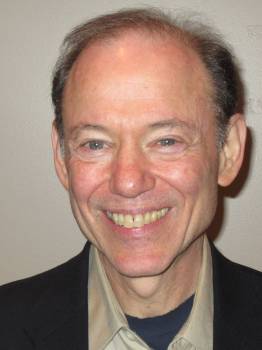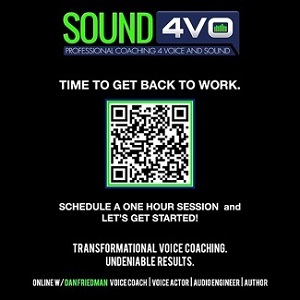|
AUDIOBOOKS A Revealing Interview With YOU - Your AudiobookScript's Co-Director - For Actable Directions  Note: The author presents a Narrator's Workshop in Los Angeles on Saturday and Sunday, April 5-6. For details, please click here or visit his website (below). Note: The author presents a Narrator's Workshop in Los Angeles on Saturday and Sunday, April 5-6. For details, please click here or visit his website (below).By Paul Ruben
Producer, Director, Casting Professional & Teacher
In Part 1
of this series, the author has a very insightful (and humorous)
conversation with the audiobook text to find actable clues. Today,
he talks with a narrator's co-director: YOU!
I began my search for The Text's co-director, You, at John Marshall Media in New York. I'd interviewed some promising candidates, but finding the right You proved to be an elusive and exhausting endeavor. Finally: A minor miracle.
My last You of the day wafted into the studio. After minimal pleasantries, a perusal of You's Narrator's award-winning audiobook vitae, I was treated to an itemization - proffered with seminal clarity - of You's co-director responsibilities. You's actable directions immediately convinced me - and here, transparency compels me to note that my condition for acceptance was that You's views on technique be commensurate with those I espouse and teach - that I'd found the narrator's quintessential co-director: You.
SO I SAID ...
This interview was going to be a pronoun nightmare.
At that point I sprinted out the control room for our engineer, Tony Van Hoorn.
Having worked with me for over a decade, Tony politely and typically nonplussed, ignored my obfuscation and trundled into the control room. TAKE YOU WITH YOU
Settled in the booth in front of two mikes, I tentatively began ... AN INTERVIEW WITH YOU PAUL: You, welcome. Ah, this is gonna get syntactically tricky. Can you, I mean we, can we sort of try and figure You out? YOU: You is an open book. I noticed Tony's head had disappeared in his hands. PAUL: So, you are You only. No me or I? YOU: You does prefer You. But let's go grammatically conventional. PAUL: I thank you. YOU: I - ugh - thank you. I! So déclassé. I exhaled prayerful relief. AN ACTABLE ROAD MAP PAUL: Okee-dokee. You. Remember what you initially told me needed definition before you could enumerate a single actable direction for narrators? YOU: You do. Sorry. I do. I felt identity-secure. That my directions are techniques. And technique is defined as an actable performance tool whose purpose is to cause compelling storytelling. My job one is to provide the narrator with an actable, self-directing road map that compensates for what appears to be the irreversible trend. PAUL: Working either alone in a home studio or with an engineer. YOU: Directionless storytelling. PAUL: How about I specify various narrator acting challenges. You then tell me how You, as the storyteller's co-director, actably address them. YOU: Glad actably was used. That's vital. Only actable directions transform performance, and quickly I'd add. PAUL: Narrators don't have all day. YOU: Amen! EMOTIONAL CONNECTIONS PAUL: Some narrators sound emotionally uncertain, whether it's about what a character is feeling or the narrative's mood. YOU: Because they haven't emotionally connected to the text and therefore can't help reading or announcing it. PAUL: Problem noted. YOU: Now the actable antidote. While looking at the text in preparation to record, Direction #1: Verbalize your emotional state, silently or aloud. Don't utter the first word till you know how you feel: happy, sad, frustrated, angry, etc. Whatever the subtext is telling you. PAUL: You are directing your narrator to hit the page emoting. YOU: Precisely. Too often, I've tapped my narrator's psychic shoulder in mid-sentence and whispered, "Hey, what are you feeling? Right now?" Silence. PAUL: And why was that? WORDS UNFELT YOU: Because my narrator wasn't acting, just speaking words unfelt. PAUL: And your narrator's eventual response? YOU: Something like, "Well, I'm just painting the picture, setting the scene, or the character you know, comes from a bad home." PAUL: But what if the text isn't emotionally clear? YOU: The narrative's subtext - where emotionality quivers - may not be immediately recognizable or obvious or, arguably, evident. But, think of it this way: Does the author ever intend for the listener to be disengaged? Ever? Besides, emotionality is inherent in language. So it is incumbent upon narrators to dig into the subtext, like a crazed ferret if necessary, locate feeling, and reveal it. Trust me, an emotionless word is an oxymoron. WHAT OTHER TECHNIQUES? PAUL: Okay, so assuming the narrator immediately connects to the text, what other actable directions can they employ to maintain that connection? YOU: Meaning, what specific techniques can narrators physicalize, like a switch! PAUL: If you say so. YOU: Name the challenges, I'll name the switches. Oh, and these techniques are all modulation eradicators. Just thought I'd mention that perk. PAUL: Okay: Point of view, the moment, characters that speak like real people and most importantly, emotional commitment to the subtext. DON'T LET WORDS OUT EASILY YOU: Direction #2 covers all those bases: hold back, hold back, hold back. Don't let the words out easily. PAUL: You have some explaining to do. YOU: Well, that's what You, ah, I am here for. PAUL: Hold back suits all genres, comedy and drama? YOU: One size fits all. And it's physicalized like a switch, flick! PAUL: So, axiomatically. YOU: Hold back, you're in the ballpark; pour forth, you're out. PAUL: You've got my attention. HEY, HOLD BACK! YOU: When I catch my narrator la-dee-da modulating in a syncopated, smooth, or sing-song rhythm, where the micro spaces between each word and sentence are identical, I direct: Hold back! Don't let those words come out easily, metronome-like, as if you know what you're going to say in advance. PAUL: So you're directing the narrator who is speaking one word behind the other at the same pace to pause non-rhythmically. YOU: More like choke off the next word or sentence, and do not speak it. PAUL: Until? SEEKING THE SUBTEXT YOU: The subtext is discovered. PAUL: And literally holding back flicks that discovery switch? YOU: That's the technique. PAUL: What triggers the emotional discovery? YOU: Ask a neurologist. I only know that this physicalized technique forces narrators out of their inauthentic - because they’re merely rhythmically vocalizing words - comfort zone, and in those micro, held back moments, guess what pops through the text? PAUL: The subtext. YOU: Voila! And in those hesitated, non-articulated moments lurks point of view, the moment, discovery and a rhythm that more accurately represents the way real people speak. PAUL: That's storytelling. YOU: You would say so! PAUL: You did. So, let's narrow our focus to drama. THE FLAT DIRECTION YOU: Direction # 3: Flat, flat, flat. PAUL: Not applicable to comedy? YOU: No. It is a dramatic narrative's best friend direction. PAUL: Best friend? YOU: Because, whether fiction or nonfiction, flat, flat, flat simultaneously liberates organic emotion and eliminates PBES. PAUL: PBES? YOU: Phony Baloney Emphasis Syndrome. PAUL: You mean nonorganic modulation. How so? YOU: First book my narrator recorded, all the words were reported, as if their emotionality had been surgically removed. Oh, myriad voice over special effects, but no feeling. Psst! Try this: As you narrate, no emphasis. AVOIDING THE SYNDROME PAUL: Not a single word? YOU: Nada. PAUL: But ... YOU: Boring? The absolute opposite. PAUL: Really? YOU: Flat, flat, flat deprives the narrator his reflexive lurch to PBES. And when the narrator is reeeaaally flat, it's as if a trap door opens, revealing? PAUL: The subtext. YOU: Begging for connection. BUT - THE EMPHASIS? PAUL: But what about emphasis? YOU: See, flat, flat, flat isn't an outcome whose endgame is speaking in a monotone. It's an actable, storytelling technique that switches on organic subtext discovery and is simultaneously lights out to PBES. PAUL: Bottom line: Each time narrators literally flatten the voice? YOU: PBES scoots and the luscious subtext is revealed to be intuitively felt. PAUL: So long as we're on dramatic threes ... THE LESS AXIOM YOU: Direction #4: Less, Less, Less! PAUL: Less what? YOU: Volume, voice! PAUL: Axiomatically. YOU: Caution: Axiom risks one size fits all. But it also provides a palpable measure the actor can at least use to concretely regard the concept. PAUL: Okay, then. Axiomatically! YOU: Less is more. PAUL: Kind of trite, no. YOU: I stand by trite! Take a third person description of some unsuspecting lamb of a character about to be slow-mo sliced and diced by the scythe-wielding serial killer. PAUL: There's a ten on the dramatic stakes scale. YOU: Ya think! LESS, LESS, LESS ... PAUL: So you, I mean You ... YOU: Yeah, yeah, I know. PAUL: Right. You direct your narrator, how? YOU: Less, less, less! Stage whisper if the stakes are threatening, painful, gruesome or just plain horrifyingly gross. PAUL: Doesn't less volume remove dramatic choices that demand volume? YOU: The dead opposite! Less voice opens more vocal choices, not fewer. PAUL: Explain. HOW TO SCREAM IN A BOOTH YOU: Remember, audiobook narration occurs in a booth where the technology can tolerate limited volume. You can scream your brains out in a stage whisper, but not in full voice. PAUL: So, listeners' willing suspension of disbelief means that they will emotionally connect to a viscous, stage-whispered howl, even if the line says, "She screamed at the top of her lungs"? YOU: Yes. Audiobook storytelling is an intimate medium: So, you scream intimately. PAUL: Full blast would disconnect the listener. YOU: And deafen the engineer. Finally, less voice imagines drama's aesthetic soul: Fear, suspense, anger, etc. Less voice is an actable technique that instantly warns: Uh-oh, something is up here, and it's gruesome. COMEDY - GO BIG PAUL: What about comedy? Since time is short, your most potent comedy direction. YOU: In threes. PAUL: Natch! YOU: Direction #5: Big, Big, BIG! PAUL: Opposite of less. YOU: Of course. Humor is predicated on intellectual recognition - of an event, human characteristic or foible, etc. - rather than empathy for what's occurring. PAUL: So big comes in where? YOU: Big alerts us that even if a character is talking about murder, the author's aesthetic request is an associative recognition that will hopefully tickle our funny bone, rather than cause us to empathize or feel. And, axiomatically ... EXAGGERATE HERE PAUL: What else. YOU: Broad means big. Broader means bigger. PAUL: Now translate in actable parlance. YOU: The more exaggerated the narrative's syntax, axiomatically, the more license the text gives the narrator to vocally exaggerate: Long, melodramatic pauses; heightened energy, exaggerated emphasis, etc. ON TO NONFICTION ... PAUL: Nonfiction. What's the fundamental actable direction that addresses this genre's unique performance challenge? YOU: Direction #6: Dispassionately teach passionately. PAUL: Sounds cryptic. YOU: I'll open the crypt. PAUL: Uh-huh. YOU: Fiction emotionally connects character and story to listeners. Nonfiction connects only the author's feelings about his narrative to listeners. MATCH AUTHOR'S FEELINGS PAUL: How do you account for nonfiction's powerful events and characters? YOU: Right, but the nonfiction narrator's only performance obligation is matching the author's feelings about characters or events, not becoming the actual character or internalizing the event as fiction demands. PAUL: So, is the nonfiction narrator still emotionally involved? YOU: Absolutely! And here's your actable trigger: Involved with the author's need to teach this amazing story. PAUL: Why teach? YOU: Because that's nonfiction's performance purpose: Whether it's 50 ways to leave your lover, the rise and fall of an empire or the next disruptive technology. PAUL: Where's the emotionality then? FACTUAL EMOTIONS YOU: The nonfiction narrator's job one is to imbue the narrative with the author's passion to tell his story. PAUL: Kind of like that great teacher we all had or wished we did. YOU: Yes, and to be clear, dispassionately teach passionately directs the narrators' passion away from involvement with the story and its characters and to the author’s need for this important story to be understood and appreciated by the listener. PAUL: That's it? YOU: Oh, no! PAUL: One last, all encompassing, ballpark direction. YOU: For the turnstile to move - whether its comedy, drama, nonfiction. PAUL: Drum roll! ONE LAST VITAL DIRECTION YOU: Direction # 7: Up the stakes. Up, up, up. PAUL: This is about performance commitment to storytelling, eh. YOU: When my narrator fails to commit to the emotional stakes embedded in the narrative, we have a situation: WNA - Wet Noodle Acting. Trust You, nothing emotionally disconnects listeners more than WNA. PAUL: The antidote to WNA? YOU: If the stakes look like a five, make 'em an eight, an eight, make 'em a 10, and a 10: Drop your socks and grab your ... PAUL: Hey, this is a family blog! YOU: Then swing on the chandelier! OVER-ACTING, THOUGH? PAUL: What about over-commitment: Over-acting? YOU: Overcommitment occurs at about the same rate as having quadruplets. Too often WNA visits and stays like an unwelcome guest. PAUL: Okay. How about a wrap-up tweet-count of actable directions? YOU: Verbalize feeling, hold back, flat, less, big, dispassionately teach passionately, up the stakes! PAUL: Whoo-hoo! Thank you, You. YOU: Isn't that redundant.
----------------
ABOUT PAUL Paul Ruben has produced and directed numerous award-winning audiobooks for every major publisher since 1987. His many Audie Awards include work for It's Not About the Bike, Raymond and Hannah, The World is Flat, and A Slight Trick of the Mind. He also received the 2003 Grammy (Best Spoken Word Album) for Al Franken's Lies and the Lying Liars Who Tell Them, and the 2009 Grammy for Always Looking Up by Michael J. Fox. He has directed regional and summer theatre productions, contributed features on audiobook narration to AudioFile magazine, and was elected to the Audio Publishers Association Board of Directors in 2005. Based in New York City and casting and directing many first-time narrators - some of whom have become outstanding and award-winning working narrators - he also teaches audiobook narrator workshops through his company, Tribeca Audio. |
|
|
Get your bi-weekly dose here ... all things VO!
Email alerts to new VoiceOverXtra articles
On Michael Langsner's Voice-Over Roadmap Podcast
Inspiring interviews help your VO career
As of the NEW website launch, 03/22/2012










As a voice talent and audiobook narrator, I want to keep this article pinned to the inside of my booth. As a voice-over coach I love the way you get right to so many of the points "newbies" face, and all of us get tempted to fall back into.
thanks!
Randye